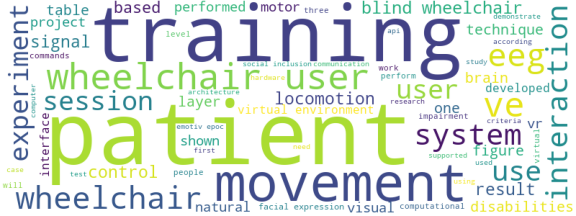| Id | 583 | |
| Author | Silva De Souza E., Cardoso A., Lamounier E. | |
| Title | A Virtual Environment-Based Training System for a Blind Wheelchair User Through Use of Three-Dimensional Audio Supported by Electroencephalography | |
| Reference | Silva De Souza E., Cardoso A., Lamounier E.; A Virtual Environment-Based Training System for a Blind Wheelchair User Through Use of Three-Dimensional Audio Supported by Electroencephalography ;Telemedicine and e-Health vol:24 issue: 8.0 page:614.0 |
|
| Link to article | https://www.scopus.com/inward/record.uri?eid=2-s2.0-85051410331&doi=10.1089%2ftmj.2017.0201&partnerID=40&md5=5a69baceae867711a8cb12e9a54199ca |
|
| Abstract | People with disabilities encounter many difficulties, especially when a diagnosis of more than one dysfunction is made, as is the case for visually impaired wheelchair users. In fact, this scenario generates a degree of incapacity in terms of the performance of basic activities on the part of the wheelchair user. The treatment of disabled patients is performed in an individualized manner according to their particular clinical aspects. People with visual and motor disabilities are restricted in independent navigation. In this navigation scenario, there is a requirement for interaction that justifies the use of virtual reality (VR). In addition, locomotion needs to be under natural control to be successfully incorporated. Based on such a condition, electroencephalography (EEG) has shown great advances in the area of health by employing spontaneous brain signals. This research demonstrates, through an experiment, the use of a wheelchair adapted to have the support of VR and EEG for training of locomotion and individualized interaction of wheelchair users with visual impairment. The objective was to provide efficient interactions, thus allowing the social inclusion of patients who are considered otherwise incapacitated. This project was based on the following criteria: Natural control, feedback, stimuli, and safety. A multilayer computer rehabilitation system was developed that incorporated natural interaction supported by EEG, which activated the movements in the virtual environment and real wheelchair through adequately performed experiments. This research consisted of elaborating a suitable approach for blind wheelchair user patients. The results demonstrated that the use of VR with EEG signals has the potential for improving the quality of life and independence of blind wheelchair users. © Everton E.S. Silva de Souza et al. 2018. |
|
| Keywords | telemedicine |
Wordcloud:



